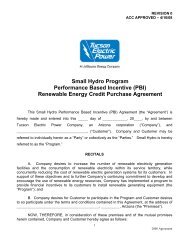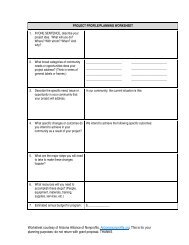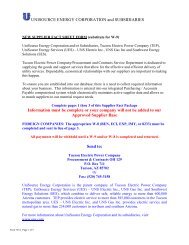Efficient Home Program Air Sealing Checklist - TEP.com
Efficient Home Program Air Sealing Checklist - TEP.com
Efficient Home Program Air Sealing Checklist - TEP.com
You also want an ePaper? Increase the reach of your titles
YUMPU automatically turns print PDFs into web optimized ePapers that Google loves.
<strong>Efficient</strong> <strong>Home</strong> <strong>Program</strong><br />
<strong>Air</strong> <strong>Sealing</strong> <strong>Checklist</strong><br />
Page 3 of 3 (rev. 3/13)<br />
Living Space<br />
Corrective Action Description<br />
1. Baseboards Caulked: The seam where exterior walls sit on the floor is often not sealed during the construction process. If<br />
a room is not carpeted, this seam was sealed by caulking the seam between the baseboard molding and the floor and the<br />
baseboard molding and the wall board. <strong>Home</strong>owner permission was gained before treating.<br />
2. Window and Door Trim Caulked: The rough opening gaps around windows and doors are often not sealed during the<br />
construction process. These seams were sealed with caulk at the connection between the trim and the window or door and<br />
the trim and the wall board. <strong>Home</strong>owner permission was gained before treating.<br />
3. Plumbing Penetrations: Often, the gaps where plumbing passes through interior finish and enters a wall or floor cavity is<br />
much larger than the pipe diameter. These penetrations usually occur inside of a cabinet and out of sight. These gaps were<br />
sealed with caulk if they were less than ¼ inch, with foam if they were up to 1 inch, or with rigid backer and foam if they were<br />
greater than 1 inch.<br />
4. Register to Floor/Wallboard Sealed: The area where a supply or return register penetrates the wall board or subfloor was<br />
sealed using duct mastic if the gap was less than ¼ inch or with backer rod and mastic if the gap was greater than ¼ inch.<br />
5. Interior Sheathing Voids Repaired: Any opening in the interior sheathing is usually a gap in the air barrier. The gap was<br />
repaired with a material similar to the surrounding materials. These repairs were discussed with the homeowner before<br />
starting to gain permission and manage expectations.<br />
6. Ext. Doors Swept and Weather Stripped: Doors between the conditioned area and the exterior or buffered spaces like<br />
garages were weather stripped with q-lon w/ carrier and the bottom of the door swept, preferably with a spring loaded power<br />
sweep. <strong>Home</strong>owner permission was gained before installing.<br />
q N/A<br />
q Action Taken<br />
q N/A<br />
q Action Taken<br />
q N/A<br />
q Action Taken<br />
q N/A<br />
q Action Taken<br />
q N/A<br />
q Action Taken<br />
q N/A<br />
q Action Taken<br />
Notes<br />
Please provide any notable details for corrective actions taken.<br />
<strong>TEP</strong> <strong>Efficient</strong> <strong>Home</strong> <strong>Program</strong> I tep.<strong>com</strong>/Efficiency I email: <strong>TEP</strong>Apps@csgrp.<strong>com</strong>








